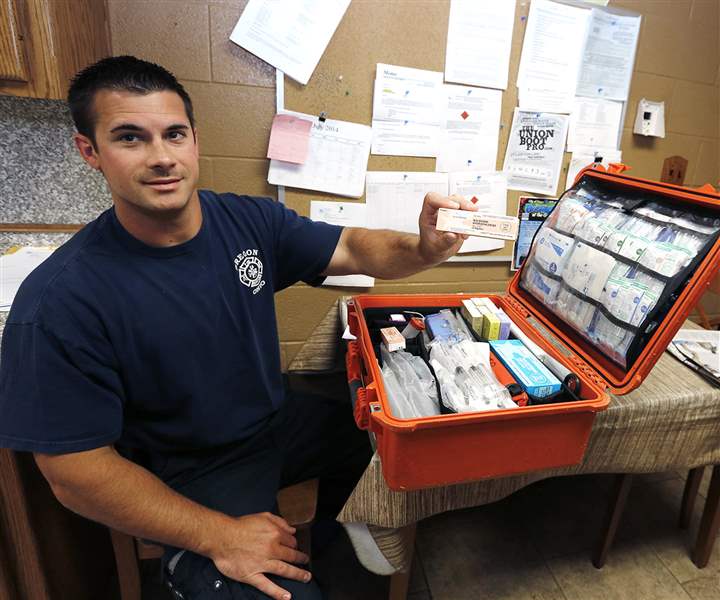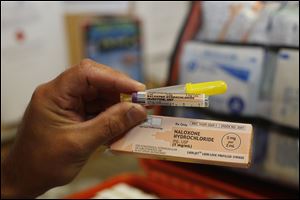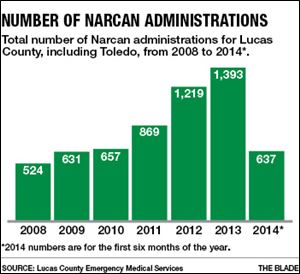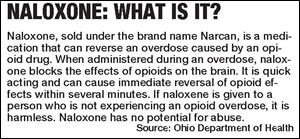
Increased access pushed locally for drug to treat overdoses
Lucas County lags state in wider use of Narcan
7/6/2014
Oregon Fire Department paramedic Greg Pollauf with naloxone, a drug that can reverse the effects of an opiod overdose. It’s often called a ‘miracle’ drug.
THE BLADE/JETTA FRASER
Buy This Image

Oregon Fire Department paramedic Greg Pollauf with Narcan/Naloxone, a drug which can reverse the effects of an opiod overdose.
As the number of deaths from heroin and prescription drugs escalates in Lucas County and across Ohio, state officials have made it easier for safety workers to fight overdoses with naloxone, or Narcan, which is often called a “miracle” drug.
But in northwest Ohio, very little has been done to move beyond the status quo of using only paramedics — not other emergency responders, police officers, and even patients’ families — to administer the drug.
Narcan is not new.
For more than 40 years, paramedics have administered it to people overdosing and have seen them come back to life. Ohio law was revised in October to allow all first responders and emergency workers with a basic license, including volunteer firefighters and police officers, to give naloxone on the scene of an overdose in an attempt to help stem the tide of drug deaths.
In Lucas County, the county emergency medical services department supplies all the equipment and medications for life squad units, but each individual fire department provides the staff. Lucas County’s EMS director, Dr. David Lindstrom, said many parts of Ohio are limited in the number of paramedics they have. “We are not in Toledo,” he said.
There are 460 paramedics trained to use Narcan, and if a call of an overdose comes into the system, “odds are good the crew will have a paramedic and the [Lucas County] Life Squad will certainly have a paramedic on it,” he said.
Oregon so far is the only fire department in Lucas County that has moved in the direction of taking the training beyond paramedics to include the first responders, said Lucas County EMS training specialist Brent Parquette.
“We have made the change, but the drugs have not been passed out yet because we need to do some additional training. Within 30 days or less that medication will be on every medic unit in Oregon,” said Oregon Assistant Fire Chief Mark Mullins.
Dr. Lindstrom said he also is looking into starting training in early fall for basic first responders to become equipped to treat with the drug.
He said Narcan can be given in a number of ways. The most complex, which involves an IV, is primarily reserved for paramedics, but Narcan also can be sprayed in the nose with a syringe or sponge.
“We are in the process of separating the Narcan into a a pouch where they could easily get at it. Every department will have to work through that,” he said.
In major cities such as Boston and New York, police officers as well as emergency medical responders carry Narcan kits.
Shocking situation

Ohio recorded a 366 percent increase in the number of drug overdose deaths between 2000 and 2012. According to the Ohio Department of Health, there were 1,914 unintentional drug overdoses in 2012 in Ohio, and opioids (prescription or heroin) remain the driving factor behind the drug overdose epidemic in the state.

According to the Lucas County Coroner’s Office, the number of overdoses from opioids in the Toledo area continues to climb at an alarming rate. Last year there were 80 deaths in the region, about 60 percent of which were from Lucas County.

“Already in 2014 there have been 60 deaths,” Chief Toxicologist Dr. Robert Forney said.
He said we could see as many as 120 deaths by the end of the year.
“The pace that we are on is just shocking.”
As the opioid epidemic has grown, the rate of Narcan use has increased steadily across the country, the state, and locally, Mr. Parquette said. The use of the drug has more than doubled in Lucas County over the past six years from 524 doses in 2008 to 1,393 in 2013.
How it works
When naloxone is administered during an overdose, it blocks the effect of opioids on the brain and restores breathing within two to eight minutes.
“In reality when someone overdoses they basically go to sleep. Their heart rate and breathing slow down, they turn light gray or blue because of lack of oxygen. We squirt the Narcan up the nose and in about two to three minutes the respiratory rate increases, then they start blinking and coughing, and then they wake and try to fight because suddenly they realize they have overdosed,” said Seneca County EMS Director Ken Majors.

Mr. Majors said he has paramedics who respond to overdose calls who administer the drug, but he has a number of volunteer firefighters in the department as well. “All of our trucks have Narcan and there is somebody on that truck who can give it [at all] times,” he said.
High demand
Because of the national and local push by health agencies to get the drug into of the hands of basic EMTs, police, and even family members of drug addicts, there is high demand, and the pharmaceutical companies are reaping the benefit, he said.
“They have done a good job of marketing the drug, but they have not done a good job of making it available. They have made it so everybody is expecting it but our guys can’t get it,” he said.
Seneca County experienced 10 overdoses last year. Mr. Majors said he has to weigh the cost to his department of training everyone when his current protocols are serving the needs of his community.
“It’s $26 for each dose. That sounds cheap, but when you are talking about putting this in the hands of each firefighter — I have about 400 — it’s expensive and it expires every six months to a year,” he said.
In Sandusky County, the small volunteer fire department in Ballville Township, just outside Fremont, has gone through the training to administer Narcan, said Sandusky County EMS Director Jeff Jackson. Overall though, “We are not seeing the number of overdoses to justify giving it to the volunteers,” he said.
In Fremont, there were nine opiate overdoses in 2012 and 10 in 2013. “If we see a spike in the heroin overdoses our medical director has training available,” he said.
Some other Ohio communities have taken a different approach when it comes to naloxone administration by first responders.
Other approaches
In Dayton, the fire department operates similarly to Toledo’s EMS in that all life squads responding to overdose calls have a paramedic available to give Narcan in potential overdose situations. But unlike Toledo, Dayton officials have already taken steps to get even more safety workers trained to give the drug.
Dayton fire Lt. Jason Royce said the overdose rate has increased dramatically in Montgomery County. Between 2008 and 2011, the county recorded between 40 and 50 heroin-related deaths per year. In 2012, the number jumped to 93 deaths.
Lieutenant Royce said although paramedics are always on each call made by the EMTs for potential overdose situations, the department decided it would be best to get their basic EMTs trained and ready to give Narcan.
“There could be a situation where the paramedic is tied up and having the trained EMT on the scene able to do it would be helpful. Or there could be a situation where an EMT may have to [give naloxone],” he said.
Lieutenant Royce said some Dayton police officers already carry Narcan kits.
In Toledo
Toledo police Sgt. Joe Heffernan said the Toledo Police Department has decided against equipping each officer with a Narcan kit. He said the fire department’s EMS staff is usually on the scene of a suspected drug overdose before police officers so it was decided that in Toledo the fire responders would continue the process.
According to the Web site of North Carolina Harm Reduction, a nonprofit organization that focuses on reducing drug overdose deaths, there are four police departments in Ohio near Cleveland that have officers carrying the drug. They are Lorain, Medina, Medina Township, and Montville Township.
The Dayton community also has taken steps to get naloxone kits into the hands of family members of people addicted to heroin or prescription pills. The Montgomery County Alcohol, Drug Addiction, and Mental Health Services Board has funded a program administered by Samaritan Behavioral Health’s Crisis Care, a local treatment facility, to train family members to administer Narcan.
“We found that family members were having to deal with the addiction in their home and people didn’t know what to do when someone is overdosing,” said Ann Stevens, spokesman for the mental health board.
After completing a 90-minute training program, the family members are given the kits with Narcan to take home.
“It’s all in an attempt to save lives — that's the bottom line,” she said.
Contact Marlene Harris-Taylor at mtaylor@theblade.com or 419-724-6091.